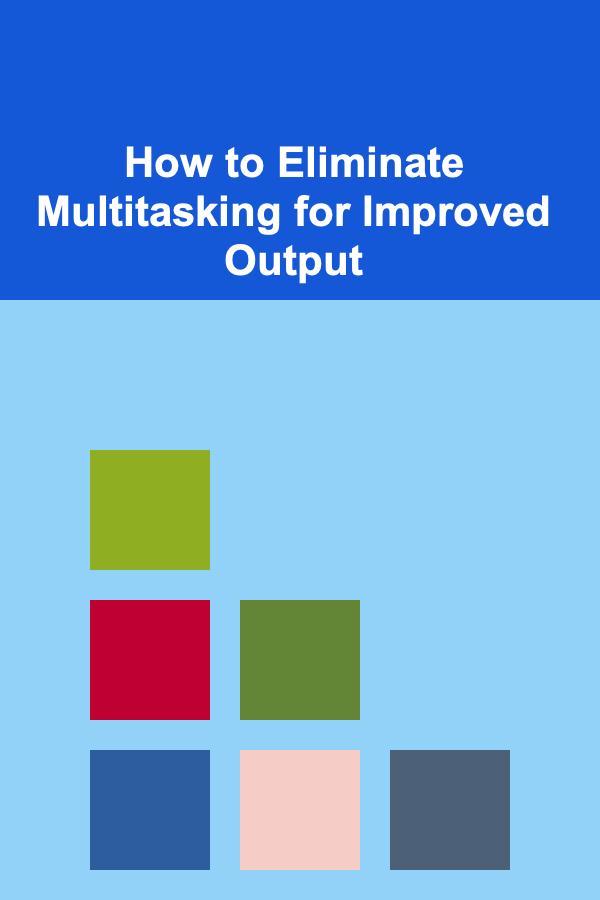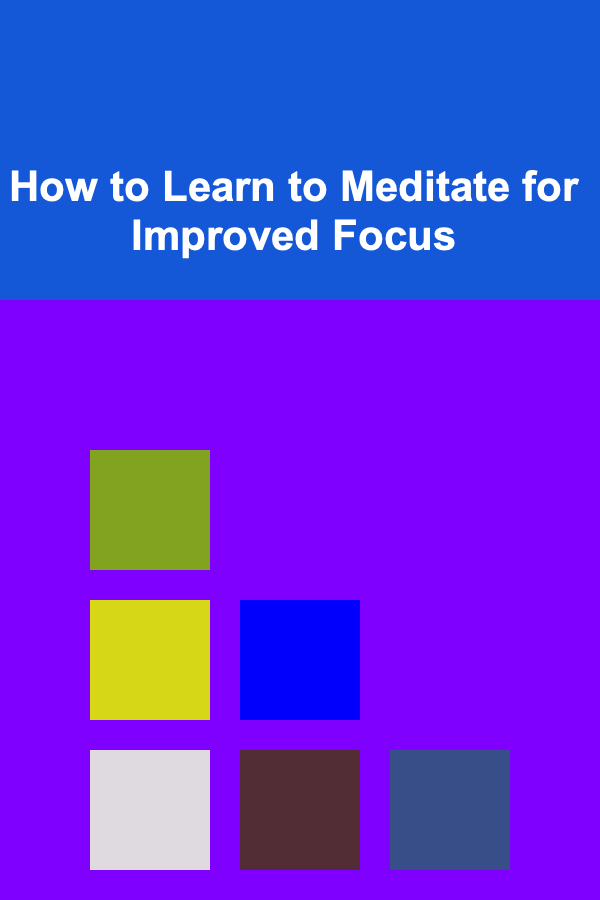
How to Eliminate Multitasking for Improved Output
ebook include PDF & Audio bundle (Micro Guide)
$12.99$6.99
Limited Time Offer! Order within the next:

In today's fast-paced world, multitasking is often seen as a desirable skill. The ability to juggle multiple tasks at once is viewed as a sign of efficiency and productivity. However, emerging research suggests that multitasking may actually hinder performance, diminish focus, and negatively impact overall productivity. The notion that we can perform two or more tasks at once, especially complex tasks, is not only a myth but also a potential productivity killer.
This article delves into why multitasking can be detrimental to output, the science behind why our brains struggle to handle multiple tasks at once, and practical strategies for eliminating multitasking to enhance performance, focus, and quality of work.
The Myth of Multitasking
Multitasking, or the act of handling more than one task simultaneously, has become a cultural norm. From answering emails while attending meetings to talking on the phone while preparing dinner, people often pride themselves on their ability to juggle tasks. However, multitasking is not as efficient as it seems.
What Happens When We Multitask?
Our brains are not designed to perform multiple tasks at the same time, especially tasks that require higher cognitive involvement. Instead of processing tasks simultaneously, the brain rapidly switches between them, a process known as "task-switching."
When we switch between tasks, there's a cost in terms of both time and cognitive resources. The mental energy spent on switching gears reduces overall efficiency. Research has shown that task-switching can slow down performance by up to 40%, and it leads to more mistakes, lower quality of work, and greater cognitive fatigue.
The Cognitive Cost of Multitasking
One of the primary reasons multitasking is ineffective is the cognitive load it creates. Each task requires a certain amount of mental energy, and when the brain is forced to divide its resources between multiple activities, each task gets less attention. This divided attention leads to:
- Decreased Focus: Switching between tasks disrupts focus and concentration. Instead of deeply engaging with one task, your attention is fragmented across multiple responsibilities.
- Increased Errors: The brain has to reorient itself each time it shifts focus from one task to another. This constant adjustment increases the likelihood of making errors, especially in complex tasks.
- Mental Fatigue: Task-switching can lead to mental exhaustion. The brain becomes overwhelmed by the continuous need to shift between tasks, reducing both cognitive capacity and efficiency over time.
- Reduced Creativity: Multitasking hinders the ability to think deeply and creatively. Deep, sustained focus on a single task allows for creative problem solving and the development of novel ideas. When multitasking, the brain is too distracted to engage in this type of focused thinking.
Why Multitasking Doesn't Work
The human brain is wired for single-task processing. In fact, neuroscientists have shown that what we think of as multitasking is really rapid task-switching. Our brains are not capable of processing two complex tasks simultaneously, especially when those tasks demand attention, focus, and memory. Instead, the brain struggles to prioritize, leading to inefficiencies and diminished output.
According to the American Psychological Association (APA), multitasking can actually impair cognitive control, leading to a decrease in both short-term and long-term memory. It also affects the brain's executive functions, which are responsible for planning, decision-making, and goal setting.
The Science of Focus: How to Train Your Brain for Single-Tasking
To improve productivity and output, we need to shift away from the myth of multitasking and focus on single-tasking. But how can we train our brains to focus better and eliminate multitasking?
Understanding the Power of Deep Work
One of the most effective ways to improve focus and productivity is to engage in what Cal Newport, a computer science professor and author of Deep Work, refers to as "deep work." Deep work is the ability to focus without distraction on a cognitively demanding task. This state of deep focus is where the most meaningful work happens.
To engage in deep work, the following steps are crucial:
- Schedule Focused Time Blocks: Set aside specific time blocks for focused, undistracted work. During these periods, commit to working on only one task, and eliminate all potential distractions. This could mean turning off your phone, closing unnecessary tabs on your computer, and informing others that you're unavailable during this time.
- Minimize Distractions: In a world full of notifications and distractions, minimizing interruptions is essential for deep work. Consider using apps that block social media or notifications during your deep work periods.
- Practice the Pomodoro Technique: The Pomodoro Technique involves working in focused intervals, typically 25 minutes, followed by a 5-minute break. This approach not only helps maintain focus but also prevents burnout.
- Create a Focused Environment: The physical space in which you work plays a significant role in your ability to concentrate. A clutter-free, quiet environment can enhance focus and reduce the likelihood of distractions.
Cultivating Mindfulness
Mindfulness, or the practice of being fully present in the moment, is a powerful tool for eliminating multitasking and enhancing focus. By cultivating mindfulness, you can train your brain to remain focused on a single task, even when distractions arise.
Research has shown that mindfulness meditation improves attention and reduces the tendency to multitask. Regular mindfulness practice strengthens your ability to concentrate on one task at a time, ultimately increasing your efficiency and reducing cognitive overload.
To incorporate mindfulness into your daily routine, consider:
- Starting the Day with Meditation: A short 10-15 minute meditation session in the morning can set the tone for the rest of the day. During this time, focus on your breath and clear your mind of distractions.
- Mindful Task Completion: Throughout the day, practice being fully present while completing each task. Rather than worrying about what's next, immerse yourself in the task at hand.
- Mindful Breaks: Taking mindful breaks during the day---such as walking outside or doing stretching exercises---can help reset your mind and increase productivity when you return to work.
Implementing the "Single-Task" Approach
To effectively eliminate multitasking, it's important to structure your day and tasks in a way that encourages single-tasking. Here are some strategies:
- Batch Similar Tasks Together: Group tasks that require similar resources or mental processes. For example, set aside a specific time in the day for answering emails, and avoid checking them throughout the day. This allows you to focus on a single type of task, reducing the need for constant task-switching.
- Prioritize Your Tasks: Begin each day by identifying the most important tasks and dedicating focused time to them. Use techniques like the Eisenhower Matrix to help prioritize tasks based on urgency and importance.
- Set Clear Boundaries: Create clear boundaries between work and personal life. During work hours, focus exclusively on work tasks. When it's time to relax, allow yourself the freedom to engage fully in personal activities without thinking about work.
- Use Technology Wisely: While technology can be a source of distraction, it can also be a tool to help streamline tasks. Use productivity apps like Trello, Todoist, or Notion to organize tasks, set deadlines, and track progress without feeling overwhelmed.
The Impact of Eliminating Multitasking on Output
Eliminating multitasking doesn't just improve focus; it can significantly enhance the quality and speed of your work.
Increased Efficiency
When you focus on one task at a time, you complete it more efficiently. This is because your brain is not expending energy on switching between tasks or trying to juggle multiple demands. As a result, you can produce higher-quality work in less time.
Higher Quality Work
By dedicating full attention to a single task, you're less likely to make errors or overlook details. This leads to higher-quality output, whether you're writing an essay, conducting research, or completing a project at work.
Reduced Stress and Burnout
Multitasking often leads to stress and burnout because it requires constant mental switching and creates a sense of being overwhelmed. By focusing on one task at a time, you reduce cognitive overload, which helps to maintain mental well-being and prevents burnout.
Improved Long-Term Retention
When you engage in single-tasking, the brain has a better chance of retaining information. This is because focused attention strengthens memory retention, making it easier to recall and apply what you've learned or worked on.
Enhanced Creativity
By eliminating distractions and allowing your mind to focus deeply on a single task, you can tap into your creative potential. Single-tasking enables you to think critically and generate innovative ideas, leading to greater creativity and problem-solving abilities.
Conclusion
Multitasking may seem like a skill that boosts productivity, but in reality, it often leads to decreased efficiency, more errors, and increased cognitive fatigue. By embracing the practice of single-tasking and eliminating multitasking from our daily routines, we can improve focus, enhance the quality of our work, and increase overall output.
To break free from the multitasking trap, we need to cultivate deep work habits, practice mindfulness, and implement strategies that prioritize single-tasking. As we train our brains to focus on one task at a time, we will unlock our full potential and produce better results with less stress and greater satisfaction.

How to Create a Checklist for Securing Your Website from SQL Injection Attacks
Read More
How to Create a Travel Inventory for Your Luggage
Read More
How to Track the ROI of AR Product Visualization in Your Dropshipping Business
Read More
How to Learn to Meditate for Improved Focus
Read More
How To Grow Microgreens for Health
Read More
How To Get Started with Co-operative Board Games
Read MoreOther Products

How to Create a Checklist for Securing Your Website from SQL Injection Attacks
Read More
How to Create a Travel Inventory for Your Luggage
Read More
How to Track the ROI of AR Product Visualization in Your Dropshipping Business
Read More
How to Learn to Meditate for Improved Focus
Read More
How To Grow Microgreens for Health
Read More